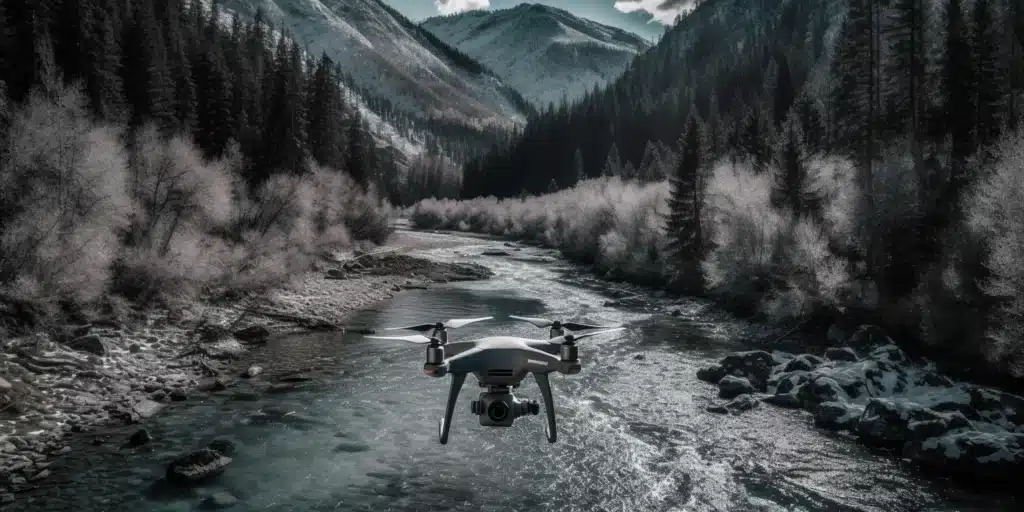LiDAR technology is revolutionizing the way we approach climate change research, providing unprecedented insights into our environment. In this article, we will explore the applications of LiDAR for Climate Change Research and how it’s shaping our understanding of global environmental challenges. From monitoring deforestation to assessing coastal erosion, LiDAR is proving to be an indispensable tool in the fight against climate change. Join us as we delve into the world of LiDAR and discover how it’s helping to create a greener, more sustainable future for our planet.
Understanding LiDAR Technology
Definition and Basics of LiDAR
LiDAR, which stands for Light Detection and Ranging, is a remote sensing technology that uses lasers to measure distances and generate high-resolution three-dimensional maps of the Earth’s surface. By emitting pulses of light and measuring the time it takes for the light to bounce back after hitting an object, LiDAR can calculate the distance to that object with great accuracy.
How LiDAR Works
LiDAR systems consist of several components, including a laser, a scanner, a Global Positioning System (GPS), an Inertial Measurement Unit (IMU), and a receiver. Here’s a step-by-step breakdown of the LiDAR process:
- The laser emits a pulse of light that travels towards the Earth’s surface.
- The light pulse hits an object (e.g., tree, building, or ground) and scatters in different directions.
- Some of the scattered light returns to the LiDAR sensor.
- The receiver detects the returning light and measures the time it took for the pulse to travel to the object and back.
- The GPS and IMU provide information about the sensor’s position and orientation.
- The LiDAR system combines distance, position, and orientation data to create a precise, three-dimensional point cloud of the scanned area.
Climate Change Challenges and the Need for LiDAR
The impacts of climate change are far-reaching, affecting ecosystems, economies, and human societies worldwide. To better understand these impacts and develop strategies for mitigation and adaptation, researchers require accurate, high-resolution data on various aspects of the Earth’s environment.
Monitoring Deforestation
Deforestation and forest degradation contribute significantly to global carbon emissions and biodiversity loss. LiDAR technology can provide detailed information about forest structure, biomass, and carbon stocks, which are crucial for monitoring and managing forests in the context of climate change.
Tracking Melting Glaciers
Melting glaciers and ice sheets due to climate change contribute to rising sea levels, posing a threat to coastal communities and ecosystems. LiDAR can be used to measure ice sheet thickness, track glacier movements, and monitor changes in snow and ice cover over time, providing valuable data for climate change research and adaptation planning.
Assessing Coastal Erosion
Coastal erosion and sea-level rise are major concerns for many coastal regions, as they can lead to loss of land, infrastructure, and habitats. LiDAR technology can be used to create accurate, high-resolution elevation models of coastal areas, enabling researchers to study coastal erosion processes and assess the vulnerability of coastal communities to sea-level rise.
Studying Land Cover Changes
Land cover changes, such as urbanization, agricultural expansion, and ecosystem degradation, can significantly influence regional and global climate patterns. LiDAR-based remote sensing allows for detailed mapping and monitoring of land cover changes, providing valuable data for understanding the impacts of climate change on ecosystems and human societies.
LiDAR Applications in Climate Change Research
LiDAR technology has proven to be a versatile tool for studying various aspects of climate change, providing accurate and detailed data to researchers and decision-makers.
Forest Management, Carbon Sequestration, and Forest Degradation
Forests play a crucial role in the global carbon cycle, acting as both carbon sinks and sources. Monitoring forest cover, biomass, and carbon stocks is essential for understanding and mitigating the impacts of climate change. LiDAR can generate accurate, high-resolution data on forest structure and composition, enabling researchers to:
- Quantify carbon stocks and fluxes in forests
- Assess the impacts of deforestation and forest degradation on carbon emissions
- Monitor reforestation and afforestation efforts
- Develop strategies for sustainable forest management and carbon sequestration
Ice and Snow Mapping: Ice Sheet Thickness and Glacier Movements
Glaciers and ice sheets are among the most sensitive indicators of climate change, as they respond directly to changes in temperature and precipitation. LiDAR technology can provide essential information on ice and snow dynamics, helping researchers to:
- Measure ice sheet thickness and volume changes
- Track glacier movements and retreat
- Monitor snow cover extent and seasonal variability
- Assess the impacts of climate change on water resources and sea-level rise
Coastal Zone Management: Coastal Erosion and Sea-level Rise
Coastal zones are highly vulnerable to climate change impacts such as sea-level rise, coastal erosion, and more frequent and severe storm events. LiDAR can provide critical data for coastal zone management, enabling researchers to:
- Map and monitor coastal erosion processes
- Assess coastal vulnerability to sea-level rise and storm surges
- Develop adaptation strategies for coastal communities and ecosystems
- Support coastal habitat restoration and conservation efforts
Permafrost Thaw Mapping in Arctic Regions
Permafrost thaw due to climate change can release significant amounts of greenhouse gases, further exacerbating global warming. LiDAR technology can be used to map permafrost thaw and associated landscape changes, helping researchers to:
- Monitor permafrost degradation and thaw processes
- Assess the impacts of permafrost thaw on ecosystems and infrastructure
- Develop strategies for mitigating greenhouse gas emissions from permafrost thaw
- Inform land-use planning and decision-making in Arctic regions
Water Resources Assessment
Climate change can significantly affect water resources, with implications for human societies and ecosystems. LiDAR technology can provide valuable data on surface water and groundwater resources, enabling researchers to:
- Map and monitor changes in river and lake levels
- Assess the impacts of climate change on water availability and quality
- Develop strategies for sustainable water resource management and adaptation
Advantages of Using LiDAR for Climate Change Research
LiDAR technology offers several benefits for climate change research, making it a powerful tool for studying and addressing the complex challenges posed by a changing climate:
- High-resolution data: LiDAR can generate detailed, three-dimensional maps with centimeter-level accuracy, allowing for precise measurements and assessments of environmental features and changes.
- Rapid data acquisition: LiDAR systems can cover large areas quickly and efficiently, providing up-to-date information for climate change monitoring and decision-making.
- Versatility and flexibility: LiDAR can be used to study various aspects of climate change, from deforestation to glacier dynamics, making it a versatile tool for a wide range of research applications.
- Integration with other data sources: LiDAR data can be combined with other remote sensing and in-situ data sources, such as satellite imagery and field measurements, to provide a comprehensive understanding of climate change impacts and processes.
Limitations and Challenges of LiDAR for Climate Change Research
Despite its many advantages, LiDAR technology also has some limitations and challenges that need to be considered when using it for climate change research:
Cost and Accessibility
LiDAR systems, particularly airborne and satellite-based platforms, can be expensive to acquire, operate, and maintain. This can limit the availability of LiDAR data for some research projects and hinder the widespread adoption of the technology.
Weather and Environmental Conditions
LiDAR data quality can be affected by atmospheric conditions such as clouds, fog, and rain, as well as the presence of smoke or dust particles in the air. Dense vegetation or rough terrain can also reduce the accuracy and coverage of LiDAR data, making it more challenging to obtain reliable information in certain environments.
Data Processing and Analysis
Processing and analyzing LiDAR data can be complex and computationally intensive, requiring specialized software and expertise. Moreover, the large volume of data generated by LiDAR systems can pose challenges for data storage, management, and sharing.
Case Studies
The following case studies illustrate the diverse applications of LiDAR technology in climate change research and the valuable insights it can provide to researchers and decision-makers.
Example 1: LiDAR and Deforestation in the Amazon
In a study conducted in the Brazilian Amazon, researchers used LiDAR data to quantify forest biomass and carbon stocks, as well as to assess the impacts of deforestation and forest degradation on carbon emissions. The high-resolution data provided by LiDAR allowed for precise measurements of forest structure and composition, contributing to a better understanding of the role of tropical forests in the global carbon cycle and informing strategies for forest conservation and management.
Example 2: LiDAR in the Arctic for Ice and Snow Monitoring
Researchers have employed LiDAR technology to monitor ice and snow dynamics in the Arctic, including the measurement of ice sheet thickness, glacier movements, and seasonal snow cover variability. The detailed, accurate data provided by LiDAR has been crucial for understanding the impacts of climate change on polar regions and informing adaptation strategies for ecosystems and communities affected by melting ice and rising sea levels.
Example 3: LiDAR-based Coastal Vulnerability Assessment
In a coastal vulnerability assessment conducted in the United States, researchers used LiDAR data to create high-resolution elevation models of coastal areas, allowing them to analyze the potential impacts of sea-level rise and storm surges on coastal communities and ecosystems. The LiDAR-based assessment provided valuable information for coastal zone management, including the identification of vulnerable areas and the development of adaptation strategies to protect human populations and coastal habitats.
LiDAR Sensors and Instruments Used in Climate Research
Various LiDAR sensors and instruments are available for climate change research, each with its unique capabilities and applications. The choice of sensor depends on the specific research objectives and requirements.
Airborne LiDAR Systems
Airborne LiDAR systems are mounted on aircraft and are used to cover large areas with high-resolution data. These systems are particularly suited for mapping forests, ice sheets, glaciers, and coastal zones. There are two main types of airborne LiDAR systems:
- Topographic LiDAR: Primarily used for mapping land surfaces, topographic LiDAR systems emit near-infrared light and are effective for mapping vegetation, soil, and other land features.
- Bathymetric LiDAR: Designed for mapping underwater features, bathymetric LiDAR systems emit green light that can penetrate water, making them ideal for mapping coastal zones, riverbeds, and shallow lakes.
Terrestrial LiDAR Systems
Terrestrial LiDAR systems are ground-based and are typically used for smaller-scale, high-precision studies. These systems can be stationary or mobile, mounted on vehicles or other moving platforms. Terrestrial LiDAR is useful for detailed mapping of specific areas, such as urban environments, infrastructure, and geological features.
Satellite-Based LiDAR Systems
Satellite-based LiDAR systems provide global coverage, enabling large-scale climate change research. One notable example is NASA’s Ice, Cloud, and Land Elevation Satellite-2 (ICESat-2), which uses the Advanced Topographic Laser Altimeter System (ATLAS) to measure changes in ice sheet elevation, sea ice thickness, and global vegetation.
LiDAR Data Processing Techniques for Climate Change Studies
Processing and analyzing LiDAR data is a critical step in extracting meaningful information for climate change research. Various data processing techniques are used to transform raw LiDAR data into useful insights.
Point Cloud Classification
Classifying the LiDAR point cloud involves assigning each point to a specific category, such as ground, vegetation, or building. This process can be performed using automated algorithms or manual interpretation. Classification helps to separate features of interest from the surrounding environment, making further analysis more manageable and efficient.
Digital Surface Model (DSM) and Digital Elevation Model (DEM) Generation
Digital Surface Models (DSMs) represent the Earth’s surface, including all natural and man-made features. Digital Elevation Models (DEMs) represent the bare ground surface, with all objects and vegetation removed. Generating these models from LiDAR data involves interpolating the point cloud to create a continuous surface that can be analyzed using various geospatial techniques.
Change Detection
Change detection is an essential aspect of climate change research, as it allows researchers to identify and quantify changes in the environment over time. By comparing LiDAR datasets acquired at different times, researchers can detect changes in land cover, vegetation, ice sheets, and other features relevant to climate change.
Integration with Other Data Sources
To gain a comprehensive understanding of climate change impacts, LiDAR data can be integrated with other data sources, such as satellite imagery, aerial photography, and in-situ measurements. Combining multiple data sources can provide valuable insights into the complex relationships between climate change processes and their effects on ecosystems and human societies.
In conclusion, LiDAR technology has immense potential in advancing our understanding of climate change and its effects on the planet. By providing accurate, high-resolution data, it enables researchers and policymakers to make informed decisions on mitigating climate change and preserving our environment. If you’re interested in learning more about LiDAR and its applications, we encourage you to visit Aerial LiDAR 101: An Introduction to its Applications and Benefits.
If you require drone services or have any questions about how Blue Falcon Aerial can assist you with your LiDAR needs, don’t hesitate to contact us. Together, we can contribute to building a more sustainable world, utilizing the power of LiDAR for climate change research.




